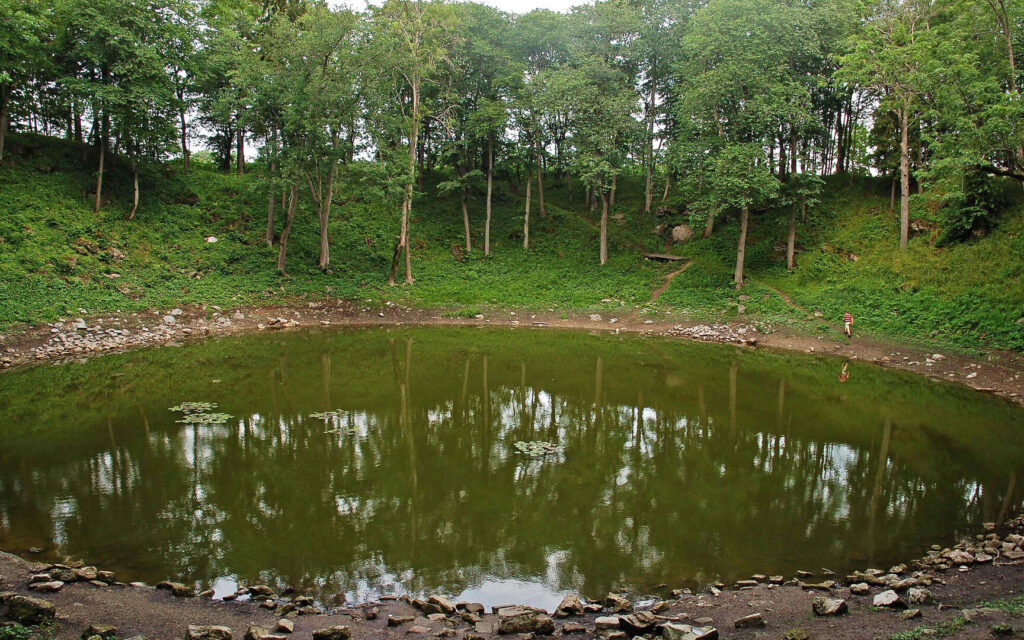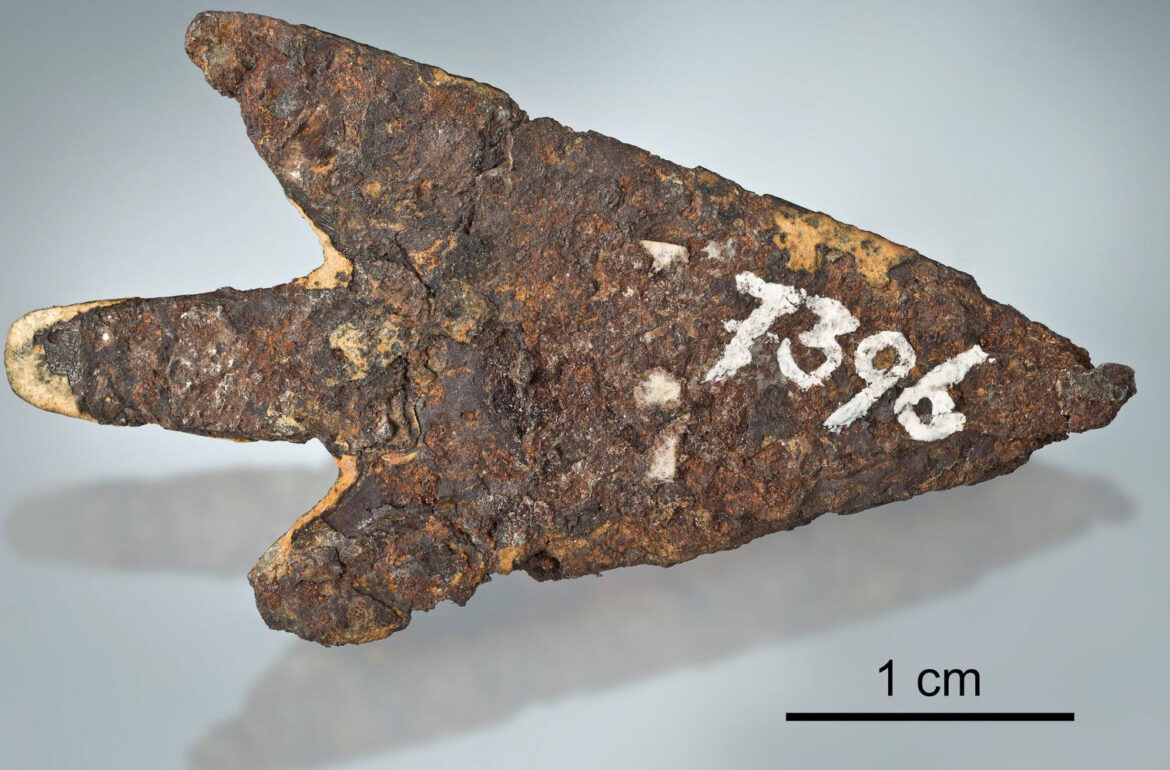Two years ago, a rare late Bronze Age arrowhead made from meteoric iron was discovered in Swiss archaeology collections. The team is now convinced that the arrowhead is made from Estonia’s Kaalijarv meteorite, which fell on the island of Saaremaa around 1,500 BCE.
“I was hoping to discover in our collection artefacts made from the iron of a meteorite that crashed near us thousands of years ago. I did not expect to find a meteoric arrow from thousands of kilometres away,” Beda Hofmann of the Natural History Museum in Bern, Switzerland, recalled.
Meteoritic iron was used to forge pre-Iron Age artefacts
At least a thousand years before the discovery of smelting iron from ores, metallic iron was available to humans in the form of rare meteoritic iron. Finds of such artefacts in central and western Europe are very scars and until now were found only in two sites in Poland: the two Czestochowa-Rakowa bracelets and the Wietrzno axe. A little over 50 pre-Iron Age meteoritic artefacts from 21 sites are known from Eurasia and northern Africa. In other parts of the world, meteoritic iron is of younger date, starting about 2,000 years ago in North America.
The so-called heavenly gifts were mainly used to forge tools and weapons. Siderites are the most common meteorites to reach the Earth’s surface, consisting primarily of iron and, to a lesser extent, nickel and other metals. Jüri Peets, a senior researcher in the department of archaeology at Tallinn University who has studied the forgeability of meteorite iron, said, “Of the most important finds in Europe, there are only spearheads from Belarus (eastern Europe).”
The cause of the scarcity is evident: although thousands of meteoroid objects strike Earth each year, many evaporate in the atmosphere, or no one is around to observe where they land. Also, prior to the Iron Age, most people would not know what to do with the pile of iron in front of them. “And following the Iron Age, there were quicker ways to obtain ore than searching for meteorites that fell from the sky,” Hofmann explained.
Hofmann assumed there must be many more meteorite-made artefacts in museum collections than is known. “We may have believed that meteorites were used to forge breathtaking objects, like spears, but given the average size of meteorite fragments, this is not necessarily the case.”
Scientists discovered a new iron meteorite object in archaeology collections near the impact site of the Swiss meteorite
Before the last ice age, an iron meteorite crashed into the Twannberg crater field near the Mörigen settlement in Switzerland. Hofmann and his colleagues investigated nearby archaeological collections in order to confirm his hypothesis and identify objects made of meteoritic iron. The likelihood of discovering something meteoric was more significant near the meteorite impact site.
As the team scrutinized the artefacts more closely, a single object made of meteoritic iron has been indeed identified, an arrowhead with a mass of 2.9 grams, initially discovered in the 19th century from the late Bronze Age (900- 800 BCE) settlement.
The team relied on a combination of several non-destructive methods in this study: a portable X-ray fluorescence (pXRF) analyzer, Muon Induced X-ray Emission (MIXE) and gamma spectrometry; all helped to provide definitive proof of meteoritic origin and information about the size of the meteorite it originated from.
Mörigen is located just 4 to 8 kilometres southwest of the large Twannberg iron meteorite impact site, with more than 2,000 individual finds totalling about 150 kilograms. Surprisingly, however, it was soon determined that the Mörigen arrowhead was not made of iron from the Twannberg strewn field.
The radioactive variant of aluminium — aluminium-26 — played a crucial role in determining the extraterrestrial origin of the material used for this purpose; only in the atmosphere are these isotopes produced in significant quantities. However, its concentration in the arrowhead was not very high, allowing the scientists to speculate about the size of the meteoroid body that delivered the meteorite to Earth.
Thus, the chemical composition was consistent with iron IAB meteorites but not with the Twannberg meteorite: the levels of aluminium-26 indicated that the Mörigen iron originated from a very large meteorite. “The greater the size of a meteoroid, the less aluminium-26 it contains. Its outer layers function as a shield, protecting its interior from cosmic radiation. However, upon entry into the atmosphere, most of the exterior layer is destroyed by combustion,” Hofmann explained.
Thus, the scientists calculated that the meteoroid that brought this iron ore to Earth weighed at least two tons when it entered the atmosphere.
The Kaalijarv meteorite from Estonia is proposed as the most likely source of the Mörigen iron
Further analysis made it possible to restrict the candidate pool even further.
Europe is only known to have been struck by three such large IAB meteorites during that time period. In addition to the Bohumilitz meteorite, which fell in what is now the Czech Republic, and the Retuerte de Bullaque meteorite, which struck Spain, the list includes the Estonian Kaalijarv meteorite, also known as Kaali meteorite.
Kaalijarv is a large meteorite that produced a series of impact craters; the largest, called Kaalijärv, is 110 meters in diameter on the island of Saaremaa in Estonia.
- Timing: The team concluded that Kaalijarv is the most likely candidate from three fitting meteorites because of its impact age. Based on three independent studies of organic matter from the base of the Kaalijärv lake, the impact most likely occurred between 1870 and 1440 BCE, i.e. during the Bronze Age.
- Size: Moreover, due to the explosive impact, most of the meteorite mass, probably several 100 tons, was destroyed and recovered meteorite fragments (in total about 10 kilograms) are primarily small “shrapnels” resulting from the destruction of the main mass. The scientists suggested that one small fragment may be the source of the arrowhead, but detachment from larger fragments is arguably possible.
- Geographic location: The Kaalijarv meteorite could have been the most well-known meteorite during the Bronze Age in Europe, as the impact occurred in an inhabited area. The fact that a search for meteoritic iron among archaeological artefacts in near proximity of the large Twannberg strewn field only yielded a single object made from a clearly different meteorite indicates that Twannberg meteorites may not have been known at all during the Bronze Age, and moreover, other buried meteorites were also not easily identified at that time.
The above analysis pointed toward the Kaalijarv meteorite, and the team suggested that a piece of a meteorite or a finished arrowhead travelled to Switzerland from Saaremaa some 3,000 years ago.
Even though this implies a transport over of about 1,600 kilometres, the transport and trade of small iron fragments appears much more likely explanation than in the case of buried large meteorite masses.

In order to make more detailed comparisons, Hofmann asked external researchers for comparative data. “The University of Tartu Natural History Museum sent the Kaalijarv meteorite to Switzerland on an exchange premise, with the approval of the meteoritics committee of the Estonian Academy of Sciences. In return, the Estonian meteorite collection acquired the Twannberg meteorite,” Jüri Plado, associate professor of geophysics and astrophysics at the University of Tartu, explained.
Technically possible, but…
“In the Stone Age, there were already contacts between northern and central Europe; for instance, all of our flint was imported. In general, this period was continental, with the majority of trade taking place on land and rivers. So I’m not very surprised that fragments of the Kaali meteorite reached Switzerland,” Peets said.
We know from the past that Baltic amber reached Egypt thousands of years ago, among other things, even though the chain of intermediaries was long and the movement of products was slow.
Plado confirmed that it would have been possible to collect meteorite fragments in Saaremaa, as only a part of the meteorite evaporated in the atmosphere. “Larger meteorites were discovered in 2017 after the meteoroid body disintegrated in the atmosphere prior to the explosions that generated the craters. Smaller and larger meteorites were still left on the ground to be collected,” the associate professor explained.
The largest meteorite found to date, the Kaalijarv meteorite preserved in the University of Tartu Natural History Museum, weighs nearly 622 grams. So there would have been plenty of suitable material for ironmongery from a piece like that. “Based on Inuit Greenlandic working methods, the arrowhead was likely crafted using cold working. Something may break off during the process, but there is no combustion damage. It does not waste a great deal of material,” Peets continued.
“In general, this material is rather fragile, but it is suitable for making arrowheads and other small objects, such as knives or jewellery,” Plado said.
According to Peets, however, stronger evidence is necessary to link the find to the Kaalijarv meteorite. “It is such an intriguing discovery that its veracity must be proven. I wouldn’t dare to claim that there is now definitive proof based on the effort made so far.”
Plado was also hesitant, “Of the three iron meteorites of the IAB group discovered in Europe, this arrowhead’s composition is most similar to that of the Kaalijarv meteorite. However, there is always the possibility that we do not know about all of the falls and that the meteorite material originated from somewhere else.”
Hofmann agreed that additional artefacts made from the Kaalijarv meteorite would be necessary to corroborate the conclusions, but, at the same time, the Estonian meteorite is the best candidate so far. “You cannot simply drop a large meteorite body like that in the midst of the woods and expect no one to notice or for any traces to remain in the heritage. The Kaalijarv meteorite was the most significant event of its kind during the Bronze Age in Europe. It has the same composition as an arrowhead. Obviously, this is not definitive proof, but it is a strong hypothesis,” Hofmann said.
The detailed comparative analysis of an arrowhead and the Kaalijarv meteorite fragments could offer additional assurance, but the arrowhead would have to be pulverized into powder. “This heritage object would be irretrievably lost, and virtually no one agrees,” he said.
In a broader sense, Hofmann anticipated that the study would encourage future exploration and analysis of existing museum collections. “Obviously, this is pure conjecture, but who knows? Perhaps Egypt’s most renowned meteorite artefacts are much older than we currently believe,” Hofmann said.
Also, he suggested that other Bronze Age artefacts made from meteorites, particularly small ones with a very flat aspect such as the “chisels” in the grave of Tutankhamun, should be subjected to comparative analyses.
The identified arrowhead demonstrated that iron meteorites were used and traded by 800 BCE, or earlier, in Central Europe, and the team is hopeful to discover additional artefacts in other archaeological collections.
Whether or not derived from Kaalijarv, the arrowhead most likely was not a singular object and likely other worked fragments of meteoritic iron, including samples of relatively small size, are present in archaeological collections in Europe and possibly even at larger distances.
The article “An arrowhead made of meteoritic iron from the late Bronze Age settlement of Mörigen, Switzerland and its possible source” is published online in the Journal of Archaeological Science.
This article was originally published in the Estonian Broadcasting news portal ERR News.
 Back
Back



